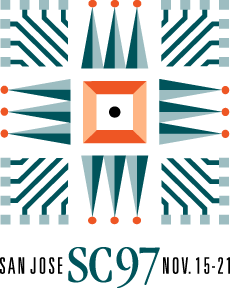Supercomputing ’97
November 15th, 1997 - November 21st, 1997
Categories: Applications, Devices, Education, Industrial VR, Networking, Software, Tele-Immersion

About
The Electronic Visualization Laboratory (EVL) participation in the Supercomputing ’97 Conference marked the first large-scale tele-immersive experiment between multiple remote sites and the SC’97 Research Exhibits.
Jason Leigh and Andy Johnson presented the research paper Issues in the Design of a Flexible Distributed Architecture for Supporting Persistence and Interoperability in Collaborative Virtual Environments. This was one of the first published papers on Tele-immersion and the CAVE Research Network (CAVERN). The research presented in this paper was supported by the multi-way collaborative demonstration of the NICE application at the National Computational Science Alliance booth. Between 15 and 20 users from I-Desks, CAVES and workstations in San Jose, and at remote sites, simultaneously and successfully inhabited the NICE environment.
Also exhibited was a rapid prototyping application using CAVERN - between the Alliance, Argonne, and the Laboratory for Advanced Computing research booths, demonstrating VR and very large databases. General Motors’ VisualEyes application demonstrated how GM designers import 3D CAD models into the CAVE for quick visual inspection and design reviews.
The Virtual Temporal Bone, a virtual reality simulation of the intricate anatomy of the middle and inner ear was also demonstrated to show the latest in networked educational systems. This type of virtual reality application will soon be a vital part of the training of resident surgeons of otolaryngology. The application was developed at the Virtual Reality in Medicine Laboratory, School of Biomedical and Health Information Sciences, College of Associated Health Professions, University of Illinois at Chicago, in collaboration with the Department of Otolaryngology, College of Medicine, and EVL.